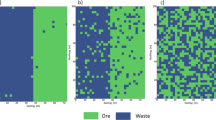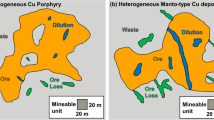Abstract
Determination of dig-limits is one of the most critical steps in grade control and short-term mine planning. Dig-limits optimization aims to maximize profit by identifying the optimal destinations of blasted materials while honoring equipment selectivity. Dig-limits determined in the pre-blast stage are not operational in the post-blast stage due to blast movement. Based on blast design configuration and rock characteristics, blasted materials will move in certain directions. The magnitude of blast movement in those directions varies across bench levels called flitches. Determining dig-limits without considering blast movement can cause significant ore losses and dilution, leading to severe financial losses. In this paper, a new methodology is proposed for quantifying uncertainty in blast movement and assessing the impact of this uncertainty on dig-limits optimization. Blast movements were modeled by using field measurement data obtained from blast movement monitoring balls that were installed in blast holes. The multivariate distributions for measured blast movements across flitches were fitted using drawable vine copula, and blast movement realizations were generated using Monte Carlo simulation. A mixed-integer linear programming model was used to determine the optimal dig-limits for all economic block models corrected and adjusted with blast movements realizations. An ore probability map was generated showing locations of ore and waste blocks in a probabilistic fashion. A case study for demonstrating the proposed methodology is presented. In this case study, two scenarios were investigated; the first scenario incorporated blast movement in determining dig-limits, while the second scenario discarded blast movement effect on dig-limits. The result of this comparison showed that discarding blast movement when determining dig-limits can lead to over-estimation of the expected profit by 65.3% when compared with the other scenario that incorporated blast movement. Post-blasting ore and waste areas with high risk of being misallocated by the dig-limits were identified.











Similar content being viewed by others
References
Aas, K., Czado, C., Frigessi, A., & Bakken, H. (2009). Pair-copula constructions of multiple dependence. Insurance: Mathematics and Economics, 44(2), 182–198.
Ardian, A., & Kumral, M. (2021). Enhancing mine risk assessment through more accurate reproduction of correlations and interactions between uncertain variables. Mineral Economics, 34, 411–425.
Chemen, R. T., & Teilly, T. (1999). Correlations of Copulas for Decision and Risk. Analysis Management Science, 45(2), 208–224.
Deutsch, M. (2017). A branch and bound algorithm for open pit grade control polygon optimization. In Proceedings of the 38th APCOM Golden, Colorado USA, Ed. Dagdelen, K., pp. 14–18.
Engmann, E., Ako, S., Bisiaux, B., Rogers, W., & Kanchibotla, S. (2013). Measurement and modelling of blast movement to reduce ore losses and dilution at Ahafo Gold Mine in Ghana. Ghana Mining Journal, 14, 27–36.
Frees, E. W., & Valdez, E. A. (1998). Understanding relationships using copulas. North American Actuarial Journal, 2(1), 1–25.
Genest, C., & Favre, A. C. (2007). Everything you always wanted to know about copula modeling but were afraid to ask. Journal of Hydrologic Engineering, 12(4), 347–368.
Gilbride, L. J. (1995). Blast-induced rock movement modelling for bench blasting in Nevada open-pit mines. (Doctoral dissertation, University of Nevada, Reno).
Harris, G. W. (1997). Measurement of blast-induced rock movement in surface mines using magnetic geophysics. (Master thesis, University of Nevada, Reno).
IBM. (2021). IBM ILOG CPLEX Optimization Studio 20.1.0 documentation. https://www.ibm.com/analytics/cplex-optimizer
Isaaks, E., Barr, R., & Handayani, O. (2014a). Modeling blast movement for grade control. In Proceedings of 9th International Mining Geology Conference; Australasian Institute of Mining and Metallurgy. p. 433–440. Adelaide, Australia.
Isaaks, E., Treloar, I., & Elenbaas, T. (2014b). Optimum dig lines for open pit grade control. In Proceedings of 9th International Mining Geology Conference. Australasian Institute of Mining and Metallurgy, pp. 425–432. Adelaide, Australia.
Kumral, M. (2015). Grade control in multi-variable ore deposits as a quality management problem under uncertainty. International Journal of Quality & Reliability Management., 32(4), 334–345.
La Rosa, D., & Thornton, D. (2011). Blast movement modelling and measurement. In Proceedings of the 35th APCOM Symposium, pp. 297–310. Wollongong, NSW, Australasian Institute of Mining and Metallurgy.
Nelis, G., & Morales, N. (2021). A mathematical model for the scheduling and definition of mining cuts in short-term mine planning. Optimization and Engineering. https://doi.org/10.1007/s11081-020-09580-1
Nelsen, R. B. (2007). An introduction to copulas. Springer.
Norrena, K., & Deutsch, C. V. (2000). Automatic determination of dig limits subject to geostatistical, economical and equipment constraints. Edmonton, Alberta, Canada: University of Alberta.
Richmond, A., & Beasley, J. (2004). Financially efficient dig-line delineation incorporating equipment constraints and grade uncertainty. International Journal of Surface Mining, Reclamation and Environment, 18(2), 99–121.
Ruiseco, J. R. (2016). Dig-limit optimization in open pit mines through genetic algorithms. (Master thesis, McGill University, Canada).
Ruiseco, J. R., & Kumral, M. (2017). A practical approach to mine equipment sizing in relation to dig-limit optimization in complex orebodies: Multi-rock type, multi-process, and multi-metal case. Natural Resources Research, 26(1), 23–35.
Ruiseco, J. R., Williams, J., & Kumral, M. (2016). Optimizing ore–waste dig-limits as part of operational mine planning through genetic algorithms. Natural Resources Research, 25(4), 473–485.
Salman, S., Muhammad, K., Khan, A., & Glass, H. J. (2021). A block aggregation method for short-term planning of open pit mining with multiple processing destinations. Minerals, 11(3), 288.
Sari, Y. A., & Kumral, M. (2018). Dig-limits optimization through mixed-integer linear programming in open-pit mines. Journal of the Operational Research Society, 69(2), 171–182.
Sinclair, A. J., & Blackwell, G. H. (2006). Applied mineral inventory estimation. Cambridge University Press.
Singh, J., Ardian, A., & Kumral, M. (2021). Gold-copper mining investment evaluation through multivariate copula-innovated simulations. Mining, Metallurgy & Exploration, 38(3), 1421–1433.
Sklar, M. (1959). Fonctions de repartition an dimensions et leurs marges. L’institut Statistique De L’université De Paris, 8, 229–231.
Tabesh, M., & Askari-Nasab, H. (2011). Two-stage clustering algorithm for block aggregation in open pit mines. Mining Technology, 120(3), 158–169.
Tabesh, M., & Askari-Nasab, H. (2013). Automatic creation of mining polygons using hierarchical clustering techniques. Journal of Mining Science, 49(3), 426–440.
Tabesh, M., & Askari-Nasab, H. (2019). Clustering mining blocks in presence of geological uncertainty. Mining Technology, 49, 426–440.
Taylor, D., & Firth, I. (2003). Utilization of blast movement measurements in grade control. In Proceedings of the 31st APCOM Symposium, Ed. Camisani-Calzolari, 243–247. South Africa.
Thornton, D., Sprott, D., & Brunton, I. (2005). Measuring blast movement to reduce loss and dilution. In International Society of Explosives Engineers Annual Conference, Ed. Jerry Wallace. Orlando, Florida, Feb 6–9, 2005. Cleveland, Ohio USA.
Vasylchuk, Y. V., & Deutsch, C. V. (2018). Optimization of surface mining dig limits with realistic selectivity. Report of Center for Computational Geostatistics, University of Alberta, Edmonton, Alberta, Canada.
Vasylchuk, Y. V., & Deutsch, C. V. (2019a). Optimization of surface mining dig limits with a practical heuristic algorithm. Mining, Metallurgy & Exploration, 36(4), 773–784.
Vasylchuk, Y. V., & Deutsch, C. V. (2019b). Approximate blast movement modelling for improved grade control. Mining Technology, 128(3), 152–161.
Wilde, B., & Deutsch, C. V. (2015). A short note comparing feasibility grade control with dig limit grade control. Report of Center for Computational Geostatistics, University of Alberta, Edmonton, Alberta, Canada.
Williams, J., Singh, J., Kumral, M., & Ruiseco, J. R. (2021). Exploring deep learning for dig-limit optimization in open-pit mines. Natural Resources Research, 30(3), 2085–2101.
Yennamani, A. L. (2010). Blast induced rock movement measurement for grade control at the Phoenix mine. (Master thesis, University of Nevada, Reno). 233 p.
Yu, Z., Shi, X., Zhou, J., Chen, X., Miao, X., Teng, B., & Ipangelwa, T. (2020). Prediction of blast-induced rock movement during bench blasting: Use of gray wolf optimizer and support vector regression. Natural Resources Research, 29(2), 843–865.
Yu, Z., Shi, X., Zhou, J., Rao, D., Chen, X., Dong, W., Miao, X., & Ipangelwa, T. (2021). Feasibility of the indirect determination of blast-induced rock movement based on three new hybrid intelligent models. Engineering with Computers, 37(2), 991–1006.
Zhang, S. (1994). Rock movement due to blasting and its impact on ore grade control in Nevada open pit gold mines (Doctoral dissertation, University of Nevada, Reno).
Zou, Z., & Jun, Y. (2021). Modelling blast movement and muckpile formation with the position-based dynamics method. International Journal of Mining, Reclamation and Environment, 35(4), 306–317.
Acknowledgments
This work was supported by the Natural Sciences and Engineering Research Council of Canada (NSERC) (Fund number: 236482). The authors thank the NSERC for this support.
Author information
Authors and Affiliations
Corresponding author
Rights and permissions
About this article
Cite this article
Hmoud, S., Kumral, M. Effect of Blast Movement Uncertainty on Dig-Limits Optimization in Open-Pit Mines. Nat Resour Res 31, 163–178 (2022). https://doi.org/10.1007/s11053-021-09998-z
Received:
Accepted:
Published:
Issue Date:
DOI: https://doi.org/10.1007/s11053-021-09998-z




